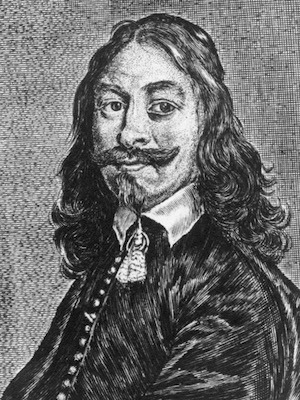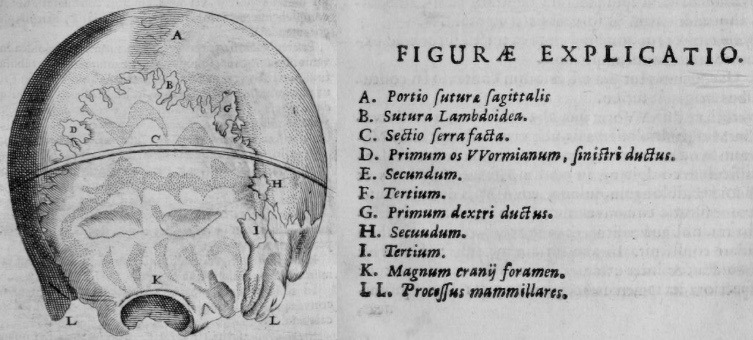Thomas Bartholin

Thomas Bartholin (1616-1680) was a Danish physician, mathematician and theologian.
Bartholin published the first full description of the human lymphatic system in 1652 and probably the first description of gallstone ileus with cholecystointestinal fistula in 1654
Bartholin’s journal, Acta medica et philosophica hafniensia, was published from 1673 to 1680 and served as a forum for disseminating his ideas.
Biography
- Born October 20, 1616 in Malmø, Scania (Originally Denmark until the Treaty of Roskilde in 1658 when the town transferred to Sweden). Son of theologian and anatomist Caspar Bartholin the Elder (1585–1629)
- 1625 – Birth of brother Rasmus Bartholin (1625-1698) discoverer of the double refraction of a light ray by Iceland spar (calcite) in 1669
- 1649 – Professor of anatomy at the University of Copenhagen
- 1655 – Father to Danish anatomist Caspar Bartholin the Younger (1655-1738), described the glands that bear the Bartholin name in 1677
- 1662 – Personal physician to King Christian V of Denmark
- 1673 – Published in Copenhagen – Acta Medica et Philosophica Hafniensia – a Danish scientific journal (1673-1680).
- Died 4 December 1680
Medical Eponyms
Bartholin-Patau syndrome (1657, 1960)
HISTORIA XLVII. Monstrum sine oculis. In oppido Scaniae nostrae Vae, natum est monstrum parentibus honestis. Recte omnia in partu successerant. Sed infanti nulli oculi erant. Bregma apertum colore rubicundo patulum. Nasus latus oblongusque ex quo tumor protendebatur una parte osseus altera carneus cute tectus, sine foraminibus narium. Os latum et deforme. Maxilla superior unico osse constare videbatur. Utraque manus sex digitis aucta, ut et pes sinister. Miserando contiuoque ejulatu omnium in se misericordiam vertit donec exspiraret
CASE 47. The monster without eyes. In the town of Vä in Sweden a monster was born of honest parentage. In the parturition everything passed off well. But the child had no eyes. There was a wide, open void of red colour. The nose broad and oblong, from which a tumour protruded, one part bony, the other part fleshy, without nostrils. The mouth wide and deformed. The upper maxilla seemed to consist of one bone. Both hands had six fingers, as had the left foot. By pitiable and continual howling the child attracted everybody’s compassion until it breathed its last.
Other Eponyms
- Bartholin Instituttet – Rigshospitalet, København: The institute carries out research within the fields of cancer and diabetes/immunology. “Our name originates from Thomas Bartholin, the Danish anatomist who discovered the lymphatic system, since many of the institute’s activities are related to the immune system.”
- Bartholinsgade, København
Key Medical Attributions
Lymphatic system (1652)
- 1651 – Jean Pecquet (1622-1674) described the thoracic duct and its entry into the veins, becoming the becoming the first person to describe the correct route of thelymphatic fluid into the blood. Bartholin provided arguably the first full description of the human lymphatic system.
- 1652 – Olaus Rudbeck (1630-1702) presented at the court of Queen Christina of Sweden that the role of lymphatic vessels was not restricted to food absorption. Instead, lymphatic vessels are distributed throughout the body and recognized that these vessels form a special system, the lymphatic vascular system (published 1653)
- 1652 – Independently confirmed the findings of Pecquet and Rudbeck and introduced the term lymphaticus
Gallstone ileus (1652)
1654 – The first case of cholecystointestinal fistula with probable entrance of a gallstone into the alimentary tract was recorded by Bartholin in 1654. [Historia LIV. Novus bilis ductus & Pancreatitis tumor]. He recorded the 1652 dissection of a female patient by German surgeon, anatomist, botanist Johannes Veslingius Mindanus [aka Johann Vesling (1598-1649)]
Interim provida natura ad bilem expurgandum alium efformaverat ductnm ab hepate prodeuntem, poro bilario a calculis constipato vicinum, qui in jejunum intestinum terminabatur.
Meanwhile, provident nature had formed another duct for the purging of bile, coming from the liver, adjacent to the biliary pore clogged with stones, which terminated in the jejunum*.
**“Jejunum” probably “duodenum”, as in the past and up until the 1900’s there was often no strict distinction between the two sections of the intestine.
Refrigeration anaesthesia (1661)
- Bartholin described the technique of Refrigeration anaesthesia in chapter XXII: Nix in cauteriis utilis, et lithotomia. Cucurbitule inditur et catbeteri of De nivis usu medico observationes variae. In this chapter he describes the use of freezing mixtures of snow and ice in the cautery of ulcers and amputation.
- Bartholin credits the Italian surgeon and anatomist Marco Aurelio Severino (1580-1656) from whom he learned the technique in Naples in 1646, with the discovery.
Wormian bones
Thomas Bartholin coined the term Ossa Wormiana (Wormian bones – small irregular bones in the sutures of the skull) in honour of his uncle Ole Worm (1588–1654) in tribute to his contributions to osteology. [Anatome 1684: 704-6]

Major Publications
Published as Thomæ Bartholini; Thomas Bartholinus; Thomas Bartholine
- Bartholini T. Anatomia, ex Caspari Bartholini parentis Institutionibus. 1651 [Collected anatomical work of his father Caspar Bartholin the elder; augmented, illustrated and revised by Thomas Bartholin. First medical textbook to incorporate Harvey’s theory of the blood’s circulation]
- Bartholini T. De lacteis thoracicis in homine brutisque nuperrime observatis historia anatomica. 1652 [The lymphatic system]
- Bartholinus T. Historiarum anatomicarum rariorum centuria I et II. 1654
- Bartholinus T. Historiarum anatomicarum rarorium centuria III et IV. 1657 [Monstrum sine oculis, p66 (Trisomy13)]
- Bartholinus T. Dispensatorium Hafniense, jussa superiorum à medicis Hafniensibus adornatum. 1658
- Bartholini T. XXII: Nix in cauteriis utilis, et lithotomia. Cucurbitule inditur et catbeteri. In: De nivis usu medico observationes variae. 1661 [Refrigeration anaesthesia]
- Bartholinus T. Dissertatio anatomica de hepate defuncto novis Bilsianorum observationibus opposita. 1661
The Bartholin family
Caspar Bartholin (the elder); two of his sons (Thomas and Rasmus); and his grandson (Caspar the younger) all served on the medical faculty of the University of Copenhagen. Between 1585 and 1738 they gained international acclaim for the institution with significant contributions to anatomical science, physics and medicine.
- Caspar Bartholin the elder (1585-1625) was a Danish polymath and Professor of medicine at the University of Copenhagen (1613-1624). His major work was Anatomicae Institutiones Corporis Humani published in 1611, where he introduced the terms nervus olfactorius and nervus vagus.
- Caspar Bartholin the younger (1655 – 1738) remembered for Bartholin glands (vulvovaginal) and Bartholin duct (salivary). Professor of philosophy at the University of Copenhagen (1674)
References
Biography
- Bibliography. Thomas Bartholin (1616 – 1680). World Cat Identities
- Portrait: Thomas Bartholinus. 1651
- Bartholin, dansk släkt af vetenskapsmän. Nordisk familjebok. 1904: 994
- Porter IH. Thomas Bartholin (1616–1680) and Niels Steensen (1638–1686): Master and pupil. Med Hist 1963; 7: 99 -125.
- Hill RV. The contributions of the Bartholin family to the study and practice of clinical anatomy, Clin Anat. 2007; 20(2): 113-115
Eponymous term
- Tjio JH, Levan A. The Chromosome Number of Man. Hereditas 1956; 42: 1-6 [First description of the number of chromosomes as 46]
- Warburg M. Anophthlmos complicated by mental retardation and cleft palate. Acta Ophthalmol (Copenh). 1960; 38: 394‐404. [First link to Bartholin original description of trisomy 13]
- Warburg M, Mikkelson M. A case of 13-15 trisomy or Bartholin-Patau’s syndrome. With a review of the ophthalmological literature concerning cases with similar symptomatology. Acta ophthal. (Kbh.), 1963; 41: 321-334. [First use of term Bartholin-Patau syndrome]
- Chikly B. Who discovered the lymphatic system [published correction appears in Lymphology 1998; 31(2): 92]. Lymphology. 1997;30(4):186‐193.
- Skobe M, Detmar M. Structure, function, and molecular control of the skin lymphatic system. J Investig Dermatol Symp Proc. 2000; 5(1): 14‐19.
Eponym
the person behind the name
